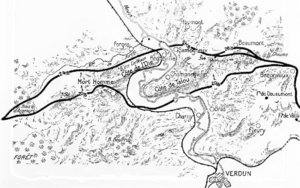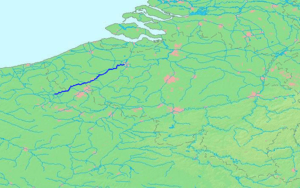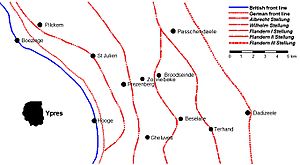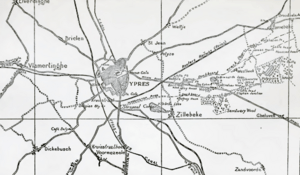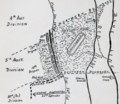Action of 25 September 1917 facts for kids
Quick facts for kids Action of 25 September 1917 |
|||||||
|---|---|---|---|---|---|---|---|
| Part of The Third Battle of Ypres, First World War | |||||||
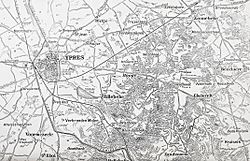 Map of the Ypres–Menin Road–Polygon Wood area, 1917 |
|||||||
|
|||||||
| Belligerents | |||||||
| Commanders and leaders | |||||||
| Crown Prince Rupprecht | Douglas Haig | ||||||
| Strength | |||||||
| 2 regiments, 1 storm battalion | 3 brigades | ||||||
The Action of 25 September 1917 was a German counter-attack during the Third Battle of Ypres. This battle was part of the First World War on the Western Front. German forces launched a planned attack, called a Gegenangriff, against British troops.
The attack happened on the front line held by the British X Corps. Two German regiments from the 50th Reserve Division attacked near the Reutelbeek stream. They used a lot of artillery, four times more than usual for a German division. German planes also helped by spotting British positions and attacking from the air.
The German infantry advanced about 100 yards on the southern side and 600 yards on the northern side. Their artillery created a "box barrage" behind the British lines. This stopped British soldiers from getting reinforcements or ammunition. British troops from the 33rd Division and the 5th Australian Division fought back. They forced the German attackers to take cover.
The Germans managed to recapture some strongholds, called pillboxes, near Black Watch Corner. These had been taken by the British earlier. However, their attempts to send more soldiers to help the attackers failed. The British commander, General Herbert Plumer, ordered a planned attack for the next day to continue.
The 33rd Division had to change its goals for the next day. They needed to cover the Australian troops and retake the lost ground. The 98th Brigade was delayed and only reached Black Watch Corner. Reinforcements helped the 5th Australian Division. By 2:00 p.m., the attack succeeded despite heavy machine-gun fire. Later, the 100th Brigade retook the ground north of the Menin road. The 33rd Division had so many casualties that another division replaced them on September 27.
Contents
Why This Battle Happened
War Strategy Changes
In 1917, the war was changing. Russia's army was weakening, which meant Germany could send more soldiers to the Western Front. To stop this, the Canadian Corps fought the Battle of Hill 70 in August. This battle prevented Germany from moving divisions to Flanders, where the main fighting was.
France also attacked the German 5th Army at Verdun in August. They captured a lot of ground and many prisoners. Germany couldn't launch big counter-attacks because their special Eingreif divisions (quick-response units) were already in Flanders. Both France and Britain were planning more attacks. Britain worried that France might make a separate peace treaty.
New Fighting Methods
The British military leaders studied how the first attacks in July went. They realized Germany was using a new defense method. Germany had strong points and concrete bunkers, called pillboxes, spread out. They also launched fast counter-attacks with local troops and Eingreif divisions.
To counter this, the British changed their strategy. They used much more artillery, especially heavy guns. These guns were meant to destroy German bunkers and machine-gun nests. The number of British artillery pieces more than doubled for this battle.
The British also set closer goals for their attacks, usually no more than 1,500 yards. After taking ground, soldiers would dig in and prepare for German counter-attacks. This way, when German Eingreif divisions attacked, they would face strong British defenses and suffer heavy losses.
After a big defeat on September 20, the German 4th Army also changed its defense. They spread out their regiments more evenly along the front line. This allowed each regiment to have a battalion ready for a quick counter-attack. The Eingreif divisions would then launch a bigger, planned counter-attack later in the day. This was meant to stop the British before they could dig in properly.
Getting Ready for Battle
German Battle Plans
On September 23, Crown Prince Rupprecht, a German commander, noted that the high ground at Zonnebeke and Gheluvelt was vulnerable. He ordered a planned counter-attack, a Gegenangriff, against the British flank. This attack would happen between the Menin Road and Polygon Wood.
The 50th Reserve Division was chosen for this attack. Their goal was to recapture about 1,800 yards of the Wilhelmstellung (a German defensive line). The attack was set for 5:15 a.m. on September 25. German artillery was greatly increased for this attack, with many more field and heavy batteries.
British Battle Plans
On September 21, the British commander, Haig, ordered the next attack across the Gheluvelt Plateau. The I Anzac Corps (Australian and New Zealand Army Corps) was to lead the main advance. They aimed to take Polygon Wood and part of Zonnebeke village.
The ground was very muddy and damaged from all the shelling. New roads and light railways were built quickly to bring artillery and ammunition forward. British artillery began continuous bombardments and practice barrages.
The British also adjusted their troop positions. The 33rd Division replaced the 23rd Division near the Menin Road. The 5th and 4th Australian Divisions replaced other Australian divisions in Polygon Wood. The 33rd Division was to support the 5th Australian Division. On September 24, the 1st Battalion, Middlesex Regiment, took over a difficult section of the front line. They arrived very early on September 25, just before the battle began.
The Battle Begins
German Attack on September 25
German soldiers of the 50th Reserve Division gathered quietly during the night. At 5:15 a.m., a massive German artillery bombardment began. German soldiers fired red flares, signaling that their own shells were falling too close to them. They moved back, then advanced closely behind the moving barrage at 5:30 a.m.
German planes flew low, firing white flares to show their troops' positions to the artillery. On the right side, the 4th Company of RIR 229 advanced against the 58th Australian Battalion. The German commander, Major Hethey, set up his headquarters in a recaptured bunker.
The attack continued, and by 11:00 a.m., the Germans had reached their goal in some areas. South of the Reutelbeek, the III Battalion, RIR 230, faced muddy ground and gained no ground. A special stormtroop battalion advanced along the Menin road but was pushed back by a British counter-attack. British prisoners told the Germans that a British attack was planned for the next day.
British 33rd Division Fights Back
At 5:15 a.m. on September 25, as the 33rd Division was finishing its troop change, a huge German bombardment started. The shelling was so intense that roads became unusable. SOS rockets were fired along the British front line, and British artillery and machine guns fired back immediately.
German infantry attacked up the Menin road, using flamethrowers. These flamethrowers shot burning oil 100 yards forward, setting dry trees on fire. The 1st Queen's forward positions were overrun. The 2nd Worcester, in reserve, lost half its strength from the shelling.
The 1/9th Highland Light Infantry quickly moved forward to fill a gap. The 4th King's also extended its line to help. On the left, the 2nd Argyll and 1st Middlesex were forced back, and some of their companies were cut off. British machine-gunners opened fire on advancing German troops. German planes then attacked these machine-gun positions, causing many casualties.
Communication with the front line was cut off, and smoke and dust covered the battlefield. Reinforcements moving forward often disappeared.
Australian 5th Division's Role
On September 25, the morning was hazy but fine. Preparations for the big British attack the next day continued. German artillery opened fire at 4:30 a.m. SOS rockets were fired by the 33rd Division and the 5th Australian Division. The German shelling was much heavier than usual.
By 7:15 a.m., a message reached the 33rd Division headquarters: the front line on the Menin road had been captured. German infantry had pushed back the 1st Middlesex and set up machine guns on the Reutelbeek road. Further south, an attack against the 4th King's was stopped.
German planes bombed the area behind the 5th Australian Division. An ammunition dump exploded, destroying trucks. The 58th Australian Battalion asked for help, and a company of the 60th Battalion was sent. Two companies of the 2nd Argyll and Sutherland Highlanders were also sent to help the 1st Middlesex counter-attack.
The 58th Australian Battalion saw German infantry advancing in small groups. Australian artillery fired quickly, but the shells fell between the German front troops and their support. The Australians fought the Germans with small arms fire. The 1st Middlesex on their right retreated, and the Germans tried to rush the Australian flank. The Australians pushed them back three times.
German machine guns were set up along the Reutel road. The Australians adjusted their line to face them. More reinforcements were requested as Germans tried to sneak into the 1st Middlesex support line.
The German shelling was very intense. More Australian troops moved forward through the shells to extend their right flank. At 10:00 a.m., Germans were seen moving towards British bunkers. The Australian Stokes mortar crews ran out of bombs.
The 58th Battalion was told about the 1st Middlesex counter-attack planned for 2:00 p.m. A company of the 60th Battalion arrived to help. Two platoons of the 2nd Argyll and Sutherland Highlanders also arrived. At 2:03 p.m., the Australians attacked, moving from shell-hole to shell-hole, pushing back the Germans.
The Scots advanced through heavy fire. They dug in about 350 yards behind the Australian flank. The main German attack ended at 11:00 a.m. German planes saw the Australian advance and British reserves moving forward, causing many casualties. The Australians considered retreating due to the number of German troops. After waiting, the Australians slowly pulled back.
The 98th Brigade planned a counter-attack for 2:03 p.m. The 15th Australian Brigade was ordered to join. By 4:55 p.m., the Australians learned the counter-attack hadn't happened. At 5:08 p.m., the 33rd Division reported success, but the 58th Battalion saw many Germans gathering. By 7:30 p.m., the 98th Brigade reported being pushed back.
By nightfall, three of the four Australian battalions meant for the next day's attack had been used. The Germans had not been fully pushed back. The 33rd Division was unsure of its troops' positions. Officers who were supposed to guide the next day's attack had been killed or wounded. Ammunition dumps had been blown up. The Germans likely knew about the planned attack for September 26.
Fighting on September 26
New British battalions, the 4th Suffolk and 5th Scottish Rifles, replaced other units for the attack on September 26. Because they didn't know the exact positions, tanks were used instead of a creeping artillery barrage. Isolated groups of British soldiers were found.
The Germans launched more counter-attacks. The 17th Division was rushed forward to attack through the 50th Reserve Division's positions. British artillery observers directed heavy fire onto the German infantry. Only a few German groups reached the front line and were pushed back by British small arms fire and bayonet charges.
As the 5th Australian Division attacked at 5:50 a.m., the Germans counter-attacked from Jerk House. They took thirty prisoners, but their commanders were killed one after another. The Germans pulled back from Jerk House at noon. Machine-gun crews saw the British advancing behind a creeping barrage.
German machine guns opened fire, and the British artillery couldn't fully stop them. One company fired over 20,000 rounds. A German regiment, Grenadier Regiment 89, was shattered by Australian artillery as it advanced. At 6:50 p.m., the Germans made a final counter-attack. A few Germans got through the artillery fire but suffered huge losses. By 8:30 p.m., the German counter-attacks stopped for the night.
What Happened Next
Soldier Losses
The 33rd Division suffered 2,905 casualties. The 5th Australian Division had 3,723 losses from September 25 to 26. The 15th Australian Brigade alone lost 1,203 men. Detailed German casualty numbers are limited, but the British attack on September 26 caused so many losses that German divisions had to be quickly replaced.
Later Actions
On September 27, the 39th Division defeated three German counter-attacks with artillery fire. On the 33rd Division front, a battalion attacked and reached its original objective for September 25. The 98th Brigade linked up with the Australians.
A quiet period followed until 4:30 a.m. on September 30. Then, fresh German divisions launched another attack with flamethrowers and smoke. This attack was against the 23rd Division, which had returned to the front. Heavy small-arms fire pushed back the German attack. A smaller attempt at 6:00 a.m. was also defeated.
See Also
Images for kids


